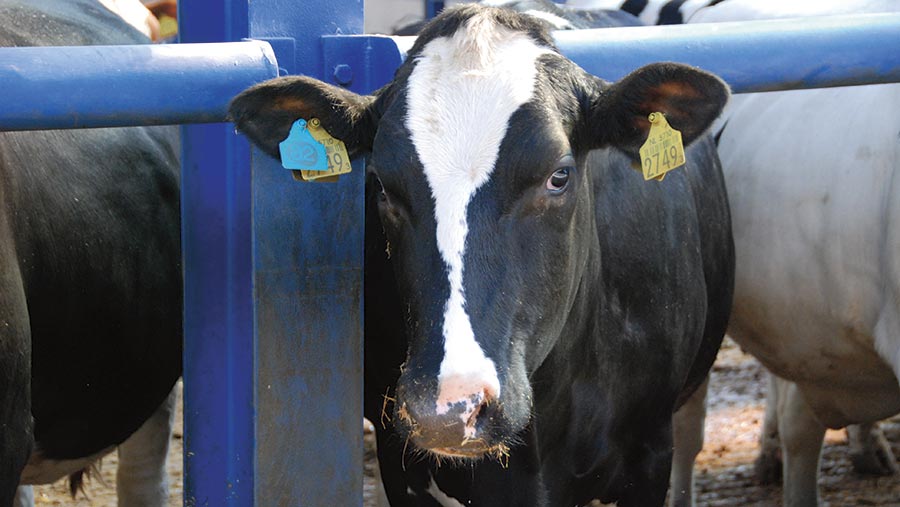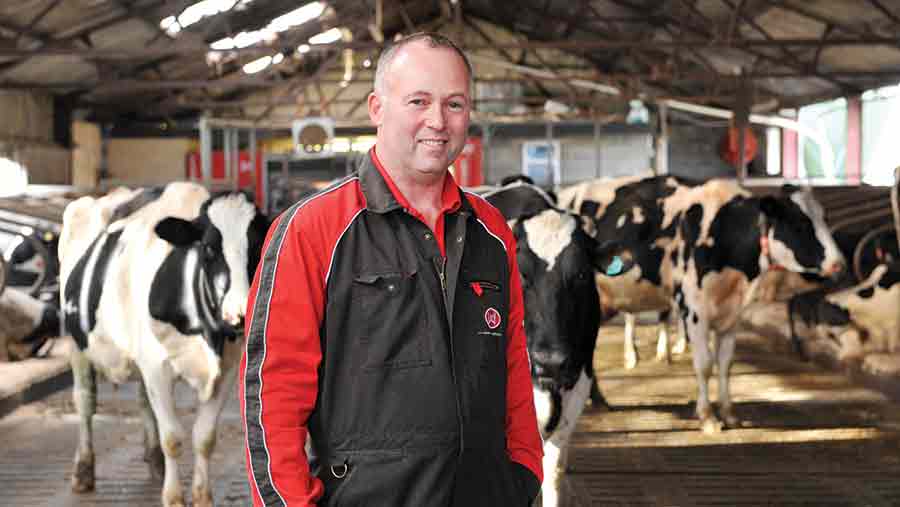How switching to A2 milk can pay off
 © Rhian Price/RBI
© Rhian Price/RBI At 30p/litre, the price paid for the A2 milk produced at Bridge Farm in Shropshire is the financial incentive that first convinced Neale Sadler to restructure his herd to include only cows with the A2 beta-casein protein.
It meant losing 57% of his cows because they didn’t test positive for the protein, and it took him four years to rebuild numbers.
See also: Milking more money from A2 production
Mr Sadler admits the business took a hit from lost milk sales and he is only getting paid 30p/litre for 10% of his milk. However, he says the outlook is very positive for the A2 market and his business.
“Milk volume is back up to where we were four years ago and there are no further costs.
“All of the A2 producers accepted it wasn’t going to be a quick fix when we signed up. We are investing in the future by producing a branded product with a fixed price.”
The a2 Milk Group has 15 farm suppliers in England and Wales and all sales of A2 milk in the UK are via the company.

Neale Sadler
Cost structure
Mr Sadler’s dip in milk production for the first two years post-conversion was cushioned by a bonus paid on all the milk he produced.
He is now paid the 2.5p/litre bonus on only 20% of his milk, and within that bonus structure he receives 30p/litre for actual A2 milk sales – currently 10%.
Farm facts
- 75 pedigree Holsteins
- 80ha farm, Edstaston near Shrewsbury.
- Some cows fully housed, some grazed from April to November
- Fed home-grown grass, maize and lucerne silages, home-produced wheat treated with caustic soda and molasses at 15% protein, fed for maintenance plus 23 litres.
- 80% of the milk produced receives standard Muller Wiseman price of 19.56p/litre. 2.5p/litre bonus on only 20% of milk, and within that bonus structure he receives 30p/litre for actual A2 milk sales – currently 10%.
For 80% of the milk he produces he receives the standard Muller Wiseman price of 19.56p/litre.
But the 10% and 20% bonus points are not fixed – these percentages are guaranteed minimums and will rise as sales go up, says Mr Sadler.
“The percentage of milk we sell into the A2 market is increasing. It was 5% at the start of this year.
“We are making progress all the time. If you look at the market for A2 milk in Australia, it took six years for that to take off and we are only four years into it.”
Premium price
A2 milk contains a different protein to conventional A1 milk and can reduce certain types of milk intolerance. As such, it can command a higher price than A1 milk.
Mr Sadler and his parents, Richard and Janet, milk 75 pedigree Holsteins on their 80ha farm at Edstaston near Shrewsbury.
They had exited milk production in 2003 because of poor prices and concentrated on rearing dairy heifers. “It was never a final decision, but it allowed us some breathing space,” says Mr Sadler.
Two years later they returned to milk production, establishing a robotic milking system with 75 cows, and supplied milk to their previous buyer, Muller.
When Muller took over Robert Wiseman Dairies, there was an opportunity to supply A2 milk to the processing factory at Market Drayton.
A2 cow incentive
As an incentive, farmers were offered a bonus of 2.5p/litre on all milk produced for two years and a further 1p/litre for milk produced by existing A2 cows in a supplier’s herd. A £300-a-cow subsidy was paid on purchases of A2 cows.
What is A2 milk?
- A2 milk is an entirely natural product made from cows that only produce A2 beta-casein protein
- Cows produce milk with two types of beta-casein protein A1 and A2
- A2 milk contains a different protein to conventional A1 milk, which can reduce milk intolerance
- A2 milk does not cure lactose intolerance
- A1 protein intolerance can cause digestive problems including abdominal pain
- A2 milk arrived on supermarket shelves in September 2012
It was an attractive financial package. “Initially, the decision to convert to A2 was purely financial, but also I’m not the sort of person who likes to run with the crowd,” says Mr Sadler.
It was a major decision nonetheless. “I had spent seven years rebuilding the herd and suddenly it was going to be decimated because I would be selling more than half of the animals.”
Dispersing the herd
He sold 57% of the herd at a dispersal sale. “It would have been impossible to run two herds on our robotic system, so it had to be all or nothing. The day after the sale we were down to 37 cows.”
There was an upside. “Our daily yields a cow immediately went up by 3-4 litres because the cows had more space and the ability to milk when they wanted.”
Mr Sadler also experienced a personal health benefit from A2 milk. “The eczema I’d had all my life disappeared after I started drinking A2 milk and it’s never come back.”
On 1 December 1, the first consignment of A2 milk left Bridge Farm.
Mr Sadler used the money from the dispersal sale to restock. At that time, A2 cows were attracting a premium, so the £300 subsidy was quickly absorbed.
Rebuilding the herd
His plans to rebuild cow numbers to 75 were hit by the milk price crisis. “I spent as much money as I could on buying the best-quality stock, but the money from the dispersal sale didn’t quite finish the herd off.
“With the milk price crashing soon afterwards, the ability to go out and buy replacement heifers disappeared. Even though we were selling non-A2 heifers that we had retained, that money was spent on paying bills. It has been a four-year process to get to where we are now.”
Suppliers no longer get the subsidy, but the A2 cow price is now on a par with the rest of the market, largely due to the intervention of the milk buyer, says Mr Sadler. “If we have surplus heifers to sell we inform the office and they will inform other producers.”
Cost of A2 cows
“When we were establishing the herd there were several farmers stocking up at the same time, so the price swallowed up the subsidy. That price has now levelled out, which is good. I don’t think A2 cows should be worth more.”
His cows are now yielding an annual average of 9,500 litres at 4.23% butterfat and 3.37% protein.
Management is identical to that of a non-A2 herd; the only point of difference is in breeding decisions. “Most of the major semen suppliers offer A2 bulls, so there is a good cross-section available”’ says Mr Sadler.
Herd management
The herd has the option to graze from April to November, but some cows choose to be fully housed. “It would be easier to house throughout the year, but I think there is a health benefit to the cows from going outside, so it is worth the hassle.”
Cows get a ration of home-grown grass, maize and lucerne silages, home-produced wheat treated with caustic soda and molasses at 15% protein, fed for maintenance plus 23 litres.
As he reflects on his decision to switch to A2 production, Mr Sadler admits it took a leap of faith.
“We were prepared to sell into a market that didn’t exist.”
With a proven track record, he is confident that it offers a good future for farmers who might have the opportunity to supply A2 milk.
“We have laid down the roots and it is now paying off with sales growth.”
